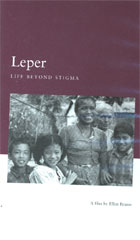
Leper: Life Beyond Stigma 2005
Distributed by The Film Library, 190 Route 17M, P.O. Box 1084, Harriman, NY 10926; 800-343-5540
Produced by Media Library
Directed by Ellen Bruno
VHS, color, 23 min.
College - Adult
Anthropology, Bioethics, Health Sciences, Psychology, Religious Studies, Sociology
Date Entered: 12/21/2005
Reviewed by Cynthia Tysick, University Libraries, University at Buffalo, State University of New York“People in the villages think it is caused by Naga spirits. So they sacrifice chickens and goats and do prayer pujas. That’s what they did for me too. My parents didn’t know.”
Ellen Bruno’s documentary of lepers in Nepal is a rare and open conversation with a societal group often shunned, feared, and misunderstood. The documentary contains poignant interviews with six men and women stricken with a disease that while scarring them on the outside leaves their beautiful spirits intact. Each one laments the sins that may have caused their affliction and ripped them from their biological families. However, they all come to Kokana with a sense of hope. There they will be among their own kind. There they will build new families, get married, have children, make new kinship bonds. Bruno sheds light on the daily life of lepers, caring for their children, cooking, cleaning, and playing board games. All of these activities are done in spite of a disease that is slowly eating away at their extremities. Fingers, toes, and nose, will all be lost to this horrific killer and Bruno does not shy away from their physical deformities. The interviewees themselves acknowledge their pain and emotional suffering with candor, humor, and an acceptance of death. It is through the acceptance of dying that many of them have found a quiet peace with life. In this documentary spirituality is a foundation for many lepers of Kokana. They have come to accept that this ailment, while possibly a curse from the gods, can only be endured through a strong religious faith.
The quality of the video is excellent, the audio clear with readable subtitles. One drawback to the video is the lack of narration. In between interviews Bruno has woven transitional scenes of the leper village. This would have been an excellent place to add narration that covered the history of the village, the causes and treatments of leprosy, and the various religious backgrounds of the inhabitants of Kokana. That said this video stands as a seminal documentary of leper society and should be included in any academic library supporting programs in anthropology, bioethics, medicine, psychology, religion, and sociology.